This Dr. Axe content is medically reviewed or fact checked to ensure factually accurate information.
With strict editorial sourcing guidelines, we only link to academic research institutions, reputable media sites and, when research is available, medically peer-reviewed studies. Note that the numbers in parentheses (1, 2, etc.) are clickable links to these studies.
The information in our articles is NOT intended to replace a one-on-one relationship with a qualified health care professional and is not intended as medical advice.
This article is based on scientific evidence, written by experts and fact checked by our trained editorial staff. Note that the numbers in parentheses (1, 2, etc.) are clickable links to medically peer-reviewed studies.
Our team includes licensed nutritionists and dietitians, certified health education specialists, as well as certified strength and conditioning specialists, personal trainers and corrective exercise specialists. Our team aims to be not only thorough with its research, but also objective and unbiased.
The information in our articles is NOT intended to replace a one-on-one relationship with a qualified health care professional and is not intended as medical advice.
The Hydrating, Detoxifying, Heart-Healthy Power of Radish Nutrition
December 20, 2023

Chances are you’ve eaten a radish before, but radishes are often overlooked ingredients in salads, side dishes and even main courses. Well, it’s high time for this veggie to get its due because radish nutrition offers a plethora of health benefits.
For instance, the radish is an alkaline-forming food, which is very helpful in keeping pH balance in check.
What else can radish nutrition do? Read on to learn the remarkable health benefits of radishes and the role radish nutrition can play in a healthy diet.
What Are Radishes?
Radishes are members of the Brassicaceae family, which also includes mustard and cabbage. The root of the radish is related to kale, broccoli, cauliflower and horseradish, to name a few.
The radish is known as a classic adornment for a leafy green salad, offering a crunchy, peppery punch, and it has actually been around for a very long time. Most states grow radishes, with Florida and California topping the growth charts.
The name origin of the radish is from the Latin word radix, and its genus name is Raphanus coming from an ancient Greek expression raphanos, meaning “easily reared.” The radish is usually seen pickled in brine, much like you see pickled cucumbers, in places like China and Japan, with nearly one third of the weight of vegetables grown in Japan being the daikon radish.
When pickled or fermented, the radish gains a beautiful yellow color that actually seems unattractive to many in the U.S. but is delicious and nutrition-packed. Regardless, it’s part of the core diet in Japan, adding a zip to the commonly consumed bowls of rice.
You’re probably familiar with the white, red, or red and white radish. Some grow the round black Spanish or long black Spanish varieties, which contain a black skin and have a bright white flesh that’s firm and crisp. There are also the rose-colored China rose and shite Strasburg, which are a part of what’s known as winter radishes and are usually stored similar to beets and turnips.
The radish is grown for many reasons, such as cooking and for the oil contained within its seeds. India grows the rat-tailed radish variety for the fleshy seed pods, while Egypt desires the tops for greens.
Radishes can be as small as a grape tomato or as big as a basketball, and the long varieties can get up to two feet long!
The radish is believed to have originated in China due to the wild varieties that have been found there, with Middle Asia noted as developing many forms after the introduction from China in prehistoric times.
Records show that radishes were very common in Ancient Egypt, even before the pyramids were built. Replicas of the radish were created in gold with beets in silver and turnips presented in lead. Ancient Greeks have written much about radishes as well as the Romans.
Larger varieties were mostly noted in northern Europe and England with a report in 1544 by a German botanist of a radish weighing in at 100 pounds! The radish became popular in Mexico around the 1500s, Haiti in 1565 and England in 1586, possibly making it one of the first European crops brought over to the Americas.
Nutrition Facts
A half-cup serving of raw radish slices (about 58 grams) contains approximately:
- Calories: 9.3
- Total Carbohydrates: 2 g
- Fiber: 0.9 g
- Sugar: 1.1 g
- Total Fat: 0.1 g
- Saturated Fat: 0.02 g
- Polyunsaturated Fat: 0.03 g
- Monounsaturated Fat: 0.01 g
- Trans Fat: 0 g
- Protein: 0.4 g
- Sodium: 22.6 mg (1% DV*)
- Vitamin C: 8.6 mg (10% DV)
- Folate: 14.5 mcg (4% DV)
- Potassium: 135 mg (3% DV)
*Daily Value: Percentages are based on a diet of 2,000 calories a day.
Health Benefits
1. Jaundice and Detoxification Treatment
The radish is believed to hold detoxification properties that help cleanse the blood of toxins and waste. It seems capable of removing bilirubin, which stabilizes production, and has been used to help treat jaundice.
In fact, research published in 2022 revealed that this vegetable has hepatoprotective effects on acetaminophen-induced liver damage. It’s also been shown to prevent “cadmium-induced biochemical and immunotoxic alterations” and promote overall detoxification.
2. Osteoarthritis Relief
Vitamin C is essential to making collagen, which is part of what makes up the much-needed cartilage in our bodies. When we think of vitamin C, we often have a vision of oranges and orange juice, but did you know that radishes are actually some of the top vitamin C foods? It’s true.
Vitamin C is an antioxidant that can help limit damage to cartilage that may be caused by free radicals found in the body. Ultimately, this can help anyone who has been diagnosed with arthritis as well as prevent it in the first place.
Radishes are also high in sulforaphane, which helps with joint pain and arthritis relief.
3. Weight Management
Radishes are typically small but pack a good bit of fiber, offering a fulfilling addition to your plate. Because fiber does not digest easily, eating fiber-rich foods can help you feel full, helping you achieve satiety and avoid overeating.
On top of that, the radish is very low in calories and contains a lot of water, which makes them a great option for almost any meal and useful for anyone trying to lose weight.
In fact, a 2022 study published in Food & Function found that a water-soluble extract of radish greens ameliorated high-fat diet-induced obesity in mice.
4. Heart Health
Radishes may help reduce incidence of heart disease. Much like red cabbage, radish nutrition contains a type of flavonoid called anthocyanins, the same flavonoid you find in blueberries.
According to research, anthocyanins possess anti-inflammatory properties that can help reduce the risk of cardiovascular disease and its effects, such as peripheral artery disease, heart failure and even kidney disease. The anthocyanins are able to circulate metabolites, which are the products of metabolic reactions catalyzed by various enzymes naturally occurring within cells.
This process could be what provides protection against many heart issues, targeting the vascular system, by reducing oxidative stress and reducing inflammation.
5. Skin Health
The radish contains many nutrients, such as B vitamins, zinc, phosphorus and vitamin C, that can help skin heal. Additionally, radish nutrition contains water, as noted above, providing much-needed hydration for the skin.
Part of what makes the radish a good choice for the skin is the antibacterial properties that help heal dry, cracked skin and prevent infection.
6. Protection Against Diabetes
Decades of research in in vitro and in vivo studies have confirmed the antidiabetic effects of radishes. As a 2017 study put it, “this may be due to its ability to enhance the antioxidant defense mechanism and reduce the accumulation of free radicals, affect hormonal-induced glucose hemostasis, promote glucose uptake and energy metabolism, and reduce glucose absorption in the intestine.”
7. Anticancer Properties
Research supports the notion that radishes are cancer-fighting foods, time and time again showing the veggie’s anticancer abilities. For instance, an ethanol extract from radish has been shown to combat human breast cancer cells, and it’s believed the sulforaphane it contains plays a role in that.
It’s also been shown to help fight colorectal cancer, esophageal cancer and more.
Recipes
Pickling is a great way to preserve food, add spice or a nice zing to almost any dish and to get some beneficial probiotics. For those who don’t enjoy the peppery zing of raw radishes, pickling may be the way to go.
Additionally, you can add health-giving herbs and spices, such as mustard, garlic, dill and turmeric — almost anything goes.
You can also try this Zoodle Salad Recipe or Mint Baked Veggies Recipe, both of which feature radishes, along with Mediterranean Diet Recipes that utilize the radish.
Here are some more radish recipes to try:
- Kimchi
- Mexican Chicken Pozole Verde
- Cobb Salad with Avocado Dressing
- Kale Caesar Salad with Salmon
- Pear Salad with Sautéed Spinach
Risks and Side Effects
Radishes are safe to eat for most people. However, if you develop a rash or an allergic reaction, stop eating immediately.
Eating large amounts of radish may irritate the digestive tract as well. There have not been any reports of problems associated with pregnancy and breastfeeding, but take caution if you feel it’s necessary.
Radishes may irritate anyone who has gallstones, so it may be best to avoid.
Final Thoughts
- The radish can be a great addition to most any diet. Eat in small amounts, and you should be able to gain the wonderful benefits of radish nutrition while enjoying a spicy punch to most any meal. For instance, radishes can help with detoxification, arthritis relief, weight management, and heart and skin health.
- For anyone who is not fond of the radish but wants the benefits, consider the recipes above, or thinly shave them onto a salad. The smaller pieces may be less noticeable and more enjoyable to eat, allowing you to obtain all the wonders of radish nutrition.









